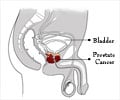Currently, doctors rely on a digital rectal exam and prostate specific antigen (PSA) when a man undergoes a prostate cancer screening.But doctors
Currently, doctors rely on a digital rectal exam and prostate specific antigen (PSA) when a man undergoes a prostate cancer screening.But doctors say there are other risk factors that could play a role. Researchers from Chicago and The Johns Hopkins Medical Institution investigated how to develop a model to accurately determine the risk of prostate cancer by including seven different risk factors.
A new study finds looking at seven different combined risk factors for prostate cancer is helpful in determining if a patient needs a prostate biopsy. For the study, researchers created a database including 3,268 men recently evaluated for the early detection of prostate cancer. The seven prostate cancer risk factors included age, race, family history, International Prostate Symptom Score, digital rectal exam and two different PSA scores. Researchers say 348 men in the database underwent prostate biopsies. Then researchers created a model that could help determine who is at the greatest risk for prostate cancer when all seven risk factors are considered.Researchers found the model is helpful at determining who should have a prostate biopsy. They found all seven risk factors played a role in the patient’s outcome. Authors say the new model gives patients a better understanding of their cancer risk and will help them decide to choose to have or not have a biopsy. The authors of the study hope this new model can be used in a clinical setting in the future.

![Prostate Specific Antigen [PSA] Prostate Specific Antigen [PSA]](https://www.medindia.net/images/common/patientinfo/120_100/prostate-specific-antigen.jpg)






